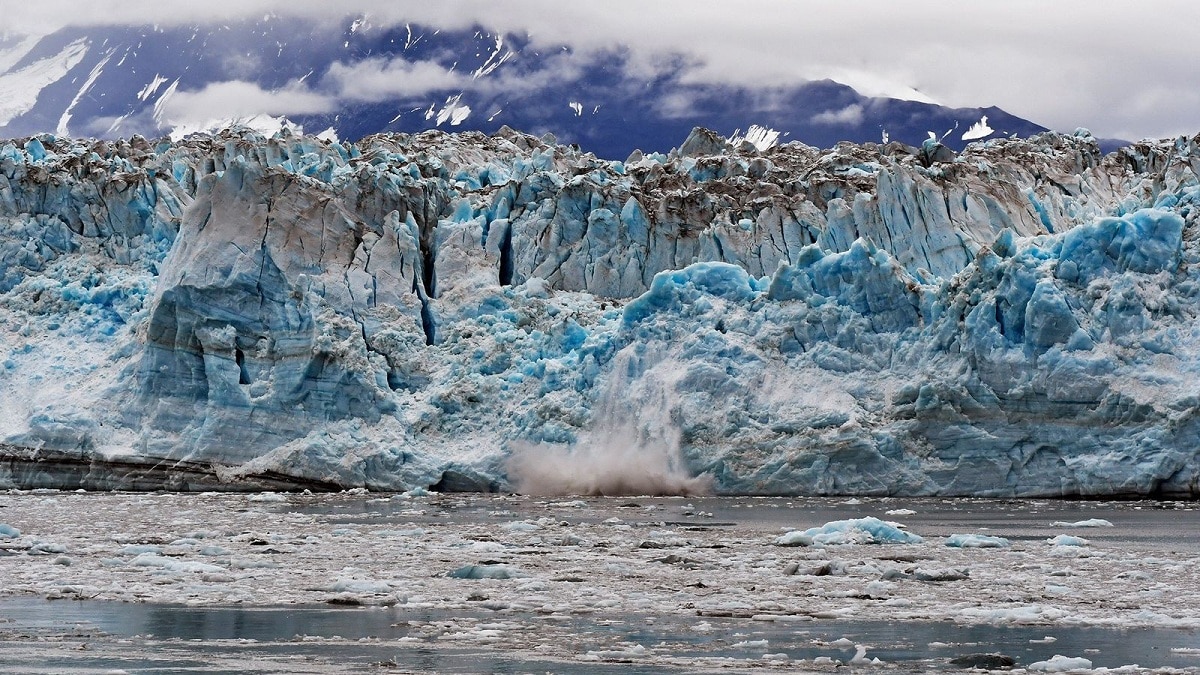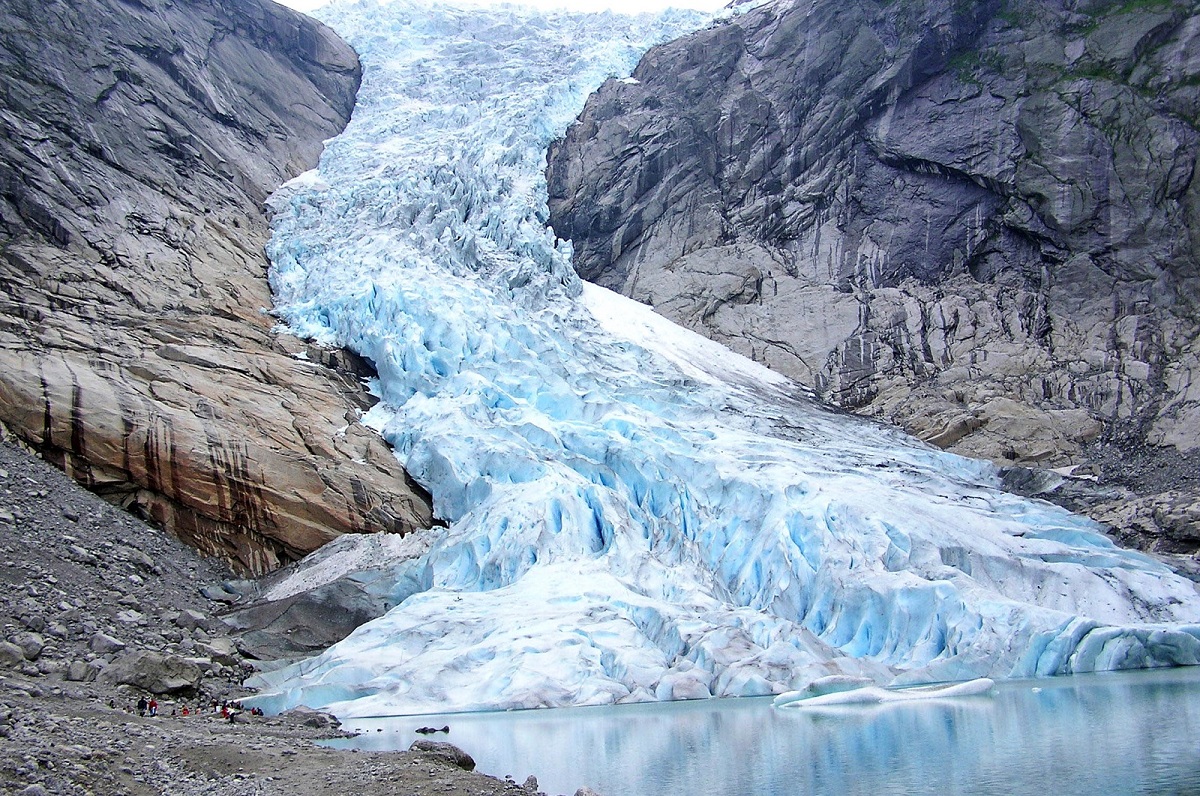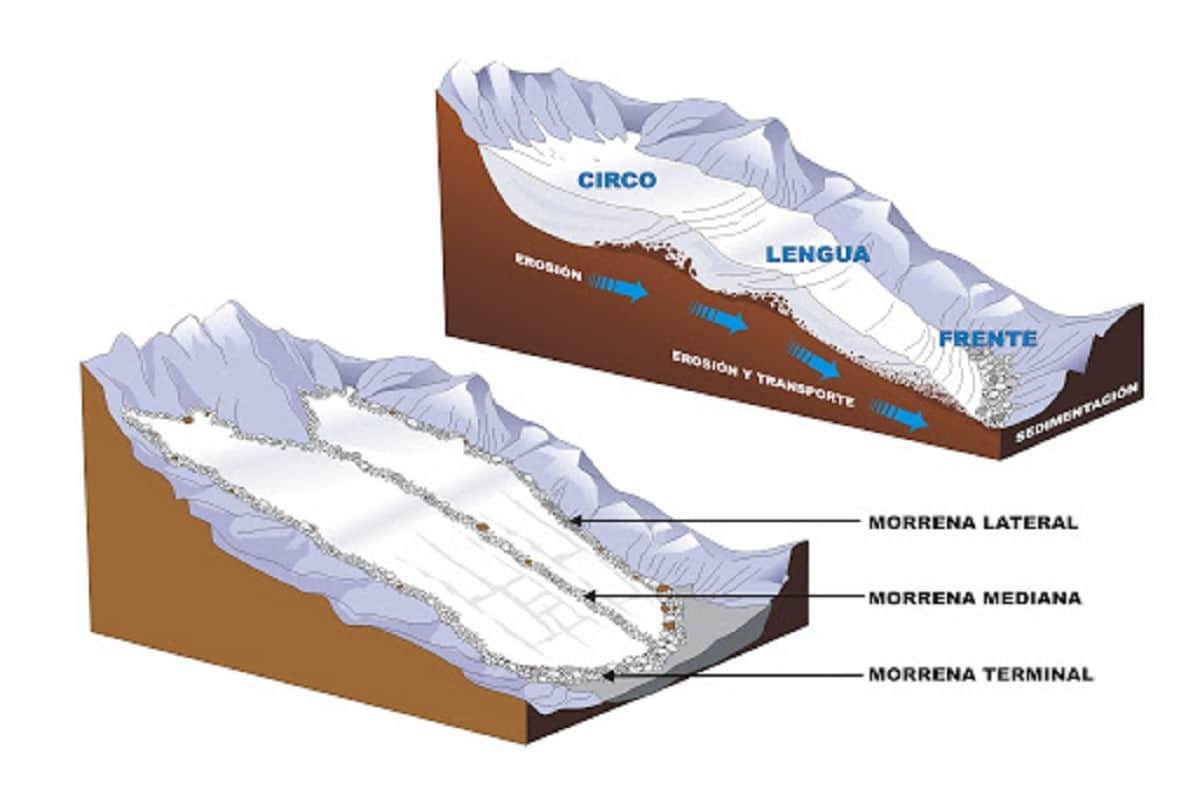
Glaciers are large masses of film ice that have formed as a result of the accumulation, compaction and control of snow over the years. These ice masses have been recrystallized and can flow downhill, building a relief known as a glacial valley. They are capable of building cracks there were some formations that have given way to the birth of water basins such as rivers, lakes and lagoons. Today we are going to focus on studying the different parts of a glacier.
In this article we are going to tell you what are the parts of a glacier and what are its main characteristics.
Glacier formation

It is estimated that 10% of the earth's surface is covered by glaciers. These ecosystems are important since 75% of the world's fresh water is retained. In addition, these glaciers play a fundamental role in the evolution of climate change worldwide. The process that leads to the formation of a glacier is known as glaciation. This process consists of the accumulation and permanence of snow continuously. This snow falls in a given area during a relatively short period of geological time. The climate of this area must be able to contribute to this process.
If the annual temperatures are more seasonal, the glacier will not be able to form as such. This is because the temperatures of the warmer seasons cause the snow to melt. The prevailing climate must have low temperatures that prevent the content from melting in times when there is an increase in temperatures. Glacier growth is generated by adding snow with the snowfall season. There are also various times when icing occurs much more frequently. Therefore, it can be said that the snow is evolving towards the freezing point. It is here where its structure is modified and crystallized, obtaining higher density as a consequence.
Glaciers maintain a balance of formation and loss of mass. The way in which they have to lose more to this melting of water in ice, sublimation and dismemberment of icebergs. These compressed ice masses are in constant and permanent mass exchange with other parts of the hydrological cycle. The lowest part of the glacier is in continuous contact with the earth's surface and causes the glacier to move. The balance between the mass gains and losses of a glacier is known as the mass balance. If the mass balance has a positive result, this glacier will increase in size. On the contrary, if it has a negative balance it will tend to fragment at an ever-increasing speed until it disappears.
Parts of a glacier

We are going to analyze one by one which are the main parts of a glacier.
Accumulation area
They are also known by the name of glacial cirque and it is the depression that occurs with the effect of glacial erosion. This glacial erosion occurs on the mountain walls and becomes the source of the valleys. In all this area the accumulation of snow that falls by precipitation predominates. This snow will gradually turn into ice and generate the glacier feeding process at its highest point.
Ablation area
On the contrary that occurs with the accumulation aria, this is the area in which the loss of ice and snow occurs. Mainly form is raised by action or thaw. In this area of the glacier the mass balance is negative. This means that the rate of ice loss is greater than that of its accumulation. Ice tends to get lost in the fusion and sublimation as well as by the detachment of large masses. This detachment occurs mainly as a consequence of the descent of the glacier to levels of interior heights. This movement towards lower elevations causes the covering of a moraine towards the surface where the dead glacier will be placed.
Glacial tongue
The glacial tongue is the area that is made up of a mass of ice that runs downhill due to the effect of gravity. As a consequence, this generates the massive dragging of rocks that gives rise to the formation of deposits that are known by the name of moraines. In this area there is a large amount of erosion and formation of a relief typical of glaciers.
Glacial moraines

It is another part of a glacier that is quite interesting to study. It is known as mountain ranges that have a glacial material that is not stratified. They are mainly composed of till. These till are nothing more than remains of sediments that have been falling through the erosion that the glacier is causing as it moves through the terrain. There are different types of glacial moraines according to some characteristics. Let's see what they are:
- Terminal moraine: It is a type of moraine that is made up of a material made up of rock fragments. These rock fragments have been removed in advance and have been deposited at the end of the glacier. The ice remains immobile continuously while the rock deposits have been displaced. It is here that the terminal moraine forms. The formation of this moraine is linked to melting and evaporation of ice. These processes occur at the end of the glacier at speeds similar to the advance of the glacier in its feeding zone.
- Bottom moraine: it is another part of a glacier composed of rock sediments. These are deposited while the ice remains immobile. The retreat of the glacier takes place, the effect of overcoming ablation towards accumulation. That is, if you lose more ice than it accumulates. This causes the sedimentation process of the feeder belt to be seen simultaneously. This belt is responsible for leaving a deposit of glacial sediments in the form of undulating plains.
- Lateral moraine: is the one that is produced by the slide of the glacier. They are usually located in mountain valleys and their solid mass movement arises in the walls of the valley where it is confined. This movement causes the debris to be stored on the sides.
- Central moraine: it is one of the parts of a glacier that is only found in alpine glaciers. Its formation is the effect of the union between 2 glaciers that form a single stream of ice.
- Ablation moraine: They are those that have been settled on the glacier bed and are composed of genius sector materials.
Parts of a glacier: terminal
It is the final area of a glacier and is composed of the lower end of it. Here ablation predominates over accumulation and is where the glacier ends.
I hope that with this information you can learn more about the parts of a glacier.